The Mughal Empire | Term 2 Unit 2 | History | 7th Social Science - Aurangzeb (1658–1707) | 7th Social Science : History : Term 2 Unit 2 : The Mughal Empire
Chapter: 7th Social Science : History : Term 2 Unit 2 : The Mughal Empire
Aurangzeb (1658–1707)
Aurangzeb (1658–1707)
Aurangzeb, the last of the Great Mughals,
started off his reign by imprisoning his old father. He assumed the title Alamgir
(the Conqueror of the World). He reigned for 48 years. He was no lover of art like
his grandfather Jahangir and architecture like his father Shah Jahan.
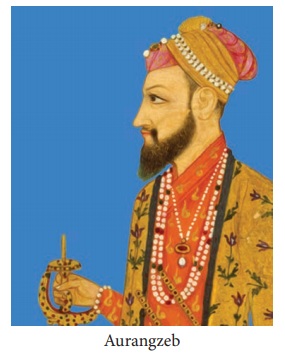
He tolerated no religion excepting Islam.
He re-imposed the jizya tax on Hindus and excluded them from office as far as possible.
Between 1658 and 1681, Aurangzeb remained in the North and suppressed the revolt
of Bundelas, Jats, Satnamis and Sikhs. Aurangzeb’s expansion in the North-East resulted
in a war with the Ahoms of Kamarupa (Assam). The kingdom came under repeated attacks
of the Mughals, but it could not be subdued totally.
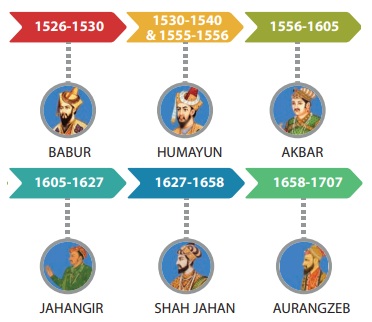
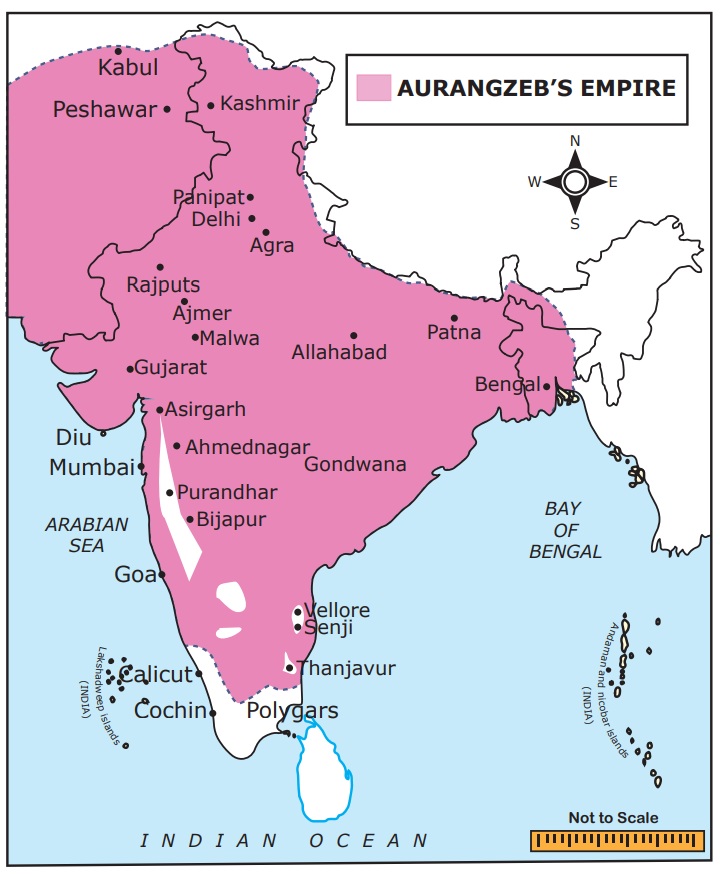
Relationship with Rajputs
and Marathas
Aurangzeb’s hostility towards Rajputs
led to prolonged wars with them. To make matters worse, his rebellious son, Prince
Akbar, joined the forces of Rajputs and created troubles to him. Prince Akbar entered
into a pact with Shivaji’s son Shambuji in the Deccan. So Aurangzeb had to march
to the Deccan in 1689.
In the Deccan, Aurangzeb brought Bijapur
and Golconda into submission. Shivaji had carved out a kingdom, proclaiming himself
the Emperor of Maratha State (1674). Aurangzeb could not stop the rise of Shivaji
in the south-west. But he vanquished Shivaji’s son and successor Shambuji, who was
captured and executed by him. Aurangzeb remained in the Deccan until his death in
1707, at the age of nearly 90.
By the end of Aurangzeb’s rule, the British
had firmly established their trade centres at Madras (Chennai), Calcutta (Kolkata)
and Bombay (Mumbai). The French had their main trade centre in Pondicherry (Puducherry).
The Mughal Administration
Central Administration
The Mughals provided a stable administration
in larger parts of India. The Emperor was the supreme head of the Mughal administrative
system. He was the law maker, the chief executive, the commander-in-chief of the
army and the final dispenser of justice. He was assisted by a council of ministers.
The most important officials were the Wakil (Prime Minister) and Wazir ordiwan (in
charge of the revenue and expenditure). Mir Bhakshi was in- charge of the army.
The Mir Saman looked after the royal household. The Qazi was the Chief Judge. Sadr-us-Sudr
was minister for enforcing Islamic law (Sharia).
Provincial Administration
The empire was divided into several Subhas
(provinces). Each Subha was under the control of an officer called Subedar. The
Subhas were further divided into districts called Sarkars. The Sarkars were subdivided
into Parganas. A group of villages (Gramas) formed a Pargana.
Local Administration
The towns and cities were administered
by Kotwals. Kotwals maintained law and order. The administration of villages was
left in the hands of local village panchayats (informal institution of justice in
villages). The Panchayatdars (jury) dispensed justice.
Army
The Mughal army comprised infantry, cavalry,
war elephants and artillery. The Emperor maintained a large number of trained and
well-armed bodyguards and palace guards.
Mansabdari System
Akbar introduced the Mansabdari system.
According to this system, the nobles, civil and military officials were combined
to form one single service. Everyone in the service was given a mansab, meaning
a position or rank. A Mansabdar was a holder of such a rank. Mansabdar rank was
dependent on Zat and Sawar. The former indicated one’s status. Sawar was the number
of horses and horsemen he had to maintain. His salary was fixed on the basis of
the number of soldiers each Mansabdar received ranging from 10 to 10,000. The Mansabdars
were paid high salary by the Emperor. Before receiving the salary, a Mansabdar had
to present his horsemen for inspection. Their horses were branded to prevent theft.
The Emperor could use the troops maintained by a Mansabdar whenever he wished. The
rank of Mansabdar was not hereditary during Akbar’s time. After him, it became hereditary.
Land Revenue Administration
Land revenue administration was toned
up during the reign of Akbar. Raja Todar Mal, Revenue Minister of Akbar, adopted
and refined the system introduced by Sher Shah. Todar Mal’s zabt system was put
in place in the north and north-western provinces. According to this system, after
a survey, lands were classified according to the nature and fertility of the soil.
The share of the state was fixed at one-third of the average produce for 10 years.
During the reign of Shah Jahan, the zabt or zabti system was extended to the Deccan
provinces.
The Mughal emperors enforced the old
iqta system, renaming it jagir. It is a land tenure system developed during the
period of Delhi Sultanate. Under the system, the collection of the revenue of an
area and the power of governing it were bestowed upon a military or civil official
now named Jagirdar. Every Mansabdar was a Jagirdar if he was not paid in cash. The
Jagirdar collected the revenue through his own officials. The Amal Guzar or the
revenue collector of the district was assisted by subordinate officers like the
Potdar, the Qanungo, the Patwari and the Muqaddams.
Those appointed to collect the revenue
from the landholders were called zamindars. Zamindars collected taxes and maintained
law and order with the help of Mughal officials and soldiers. The local chieftains
and little kings were also called zamindars. But at the end of the sixteenth century,
the zamindars were conferred hereditary rights over their zamin. The zamindar was
empowered to maintain troops for the purpose of collecting revenue. The emperor
granted lands to scholars, holy men and religious institutions. These lands called
suyurghal were tax-free.
Religious Policy
The Mughal emperors were the followers
of Islam. Akbar was very liberal in his religious policy. In Akbar’s court, the
Portuguese missionaries were great favourites. Akbar tried to include the good principles
in all religions and formulated them into one single faith called Din-I-Ilahi (divine
faith). Jahangir and Shah Jahan also followed the policy of Akbar. Aurangzeb rejected
the liberal views of his predecessors. As we pointed out earlier, he re-imposed
the jizya and pilgrim tax on the Hindus. His intolerance towards other religions
made him unpopular among the people.
Art and Architecture
Babur
introduced the Persian style of architecture to India by building many structures
at Agra, Biana, Dholpur, Gwalior and Kiul(Aligarh), but only a few of them exist
today. Humayun’s palace in Delhi, Din-i-Panah, was probably destroyed by Sher Shah
Sur who built the Purana Qila in its place. The most prominent monument of Sher
Shah’s reign was his mausoleum built at Sasaram in Bihar.
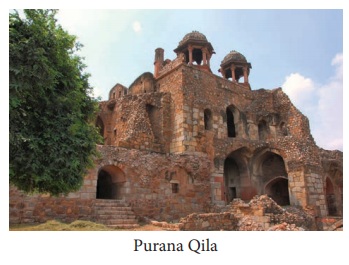
The Diwan-i-Khas, Diwan-i-Am, Panch Mahal
(pyramidal structure in five stories), Rang Mahal, Salim Chishti’s Tomb and Buland
Darwaza were built during Akbar’s time. Jahangir completed Akbar’s tomb at Sikandara
and the beautiful building containing the tomb of Itmad-ud-daula, father of Nur
Jahan, at Agra.
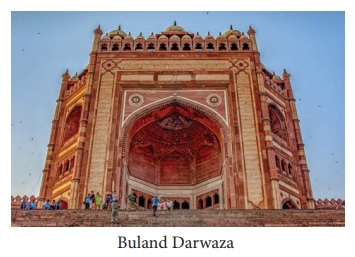
Shah Jahan’s time witnessed the climax
of Mughal splendour. The famous peacock throne, covered with expensive jewels, was
made for the Emperor to sit on. Then rose the world famous Taj Mahal, by the side
of the Jumna river at Agra. Besides Taj, he built the Moti Masjid, the pearl mosque
at Agra, the great Jama Masjid of Delhi and the Diwan-i-Khas and Diwan-i-Am in his
palace in Delhi.
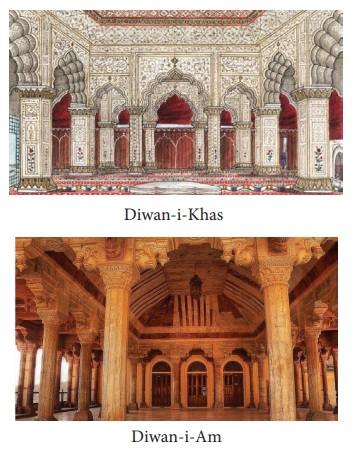
During Aurangzeb’s reign, architecture
did not receive much patronage. The Bibi Ka Maqbara in Aurangabad, a mausoleum built
by his son Prince Azam Shah as a loving tribute to his mother in the late seventeenth
century, is, however, worth mentioning.
Red Fort
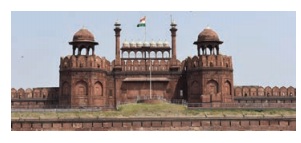
Red Fort, also called Lal Qila, in Delhi was the residence of the
Mughal emperors. Constructed in 1639 by Emperor Shah Jahan as the palace of his
fortified capital Shajahanabad. The Red Fort is named for its massive enclosing
walls of red sandstone.
Related Topics